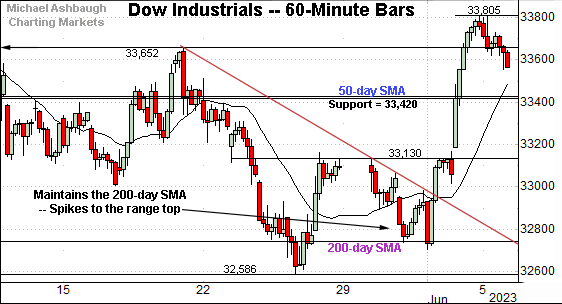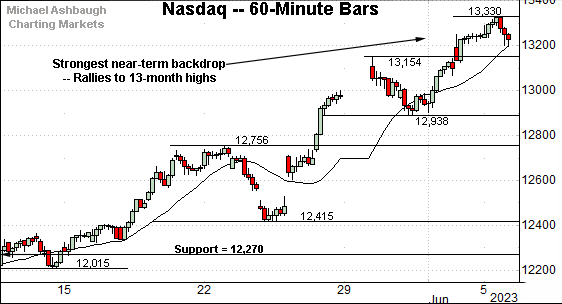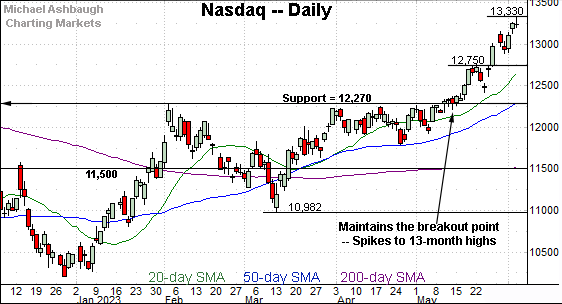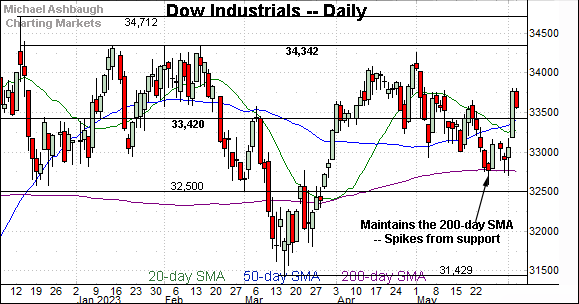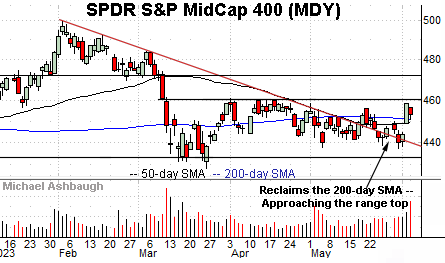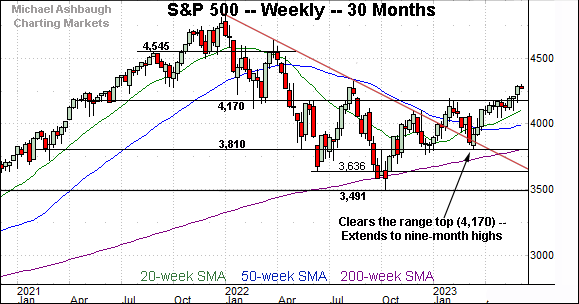Bull trend broadens, S&P 500 knifes to nine-month highs
Focus: Dow industrials maintain 200-day average, Small- and mid-caps extend trendline breakouts
Technically speaking, an already bullish bigger-picture backdrop has strengthened to start June.
On a headline basis, the S&P 500 and Nasdaq Composite have knifed to multi-month highs, rising amid statistically unusual bullish momentum. Each benchmark has staged some form of a two standard deviation breakout.
Against this backdrop, both benchmarks are near-term extended, and due a sideways chopping around phase, though the longer-term outlook remains bullish.
Editor’s Note: As always, updates can be directly accessed at https://chartingmarkets.substack.com.
Before detailing the U.S. markets’ wider view, the S&P 500’s hourly chart highlights the past four weeks.
As illustrated, the S&P 500 has broken out, knifing to nine-month highs.
The prevailing upturn originates from major support (4,170) an area also detailed on the daily and weekly charts. The June low (4,171) has registered nearby.
Meanwhile, the Dow Jones Industrial Average continues to lag behind.
Nonetheless, the index has weathered a turn-of-the-month test of its 200-day moving average.
In fact, the blue-chip benchmark started June with a two-session spike spanning 1,101 points, or 3.4%, rising sharply from the 200-day. Constructive price action.
From current levels, the 50-day moving average, currently 33,428, closely matches major support (33,420). Both areas are also detailed on the daily chart.
True to recent form, the Nasdaq Composite remains the strongest major benchmark.
As illustrated, the index has knifed to 13-month highs, rising amid bullish momentum better detailed below.
Widening the view to six months adds perspective.
On this wider view, the Nasdaq has taken flight.
The prevailing upturn punctuates a mid-May flag pattern, the tight range underpinned by the breakout point (12,270). Though near-term extended, and due to consolidate, the directionally sharp one-month spike is longer-term bullish.
(On a granular note, the prevailing spike marks a two standard deviation breakout, punctuated by three separate closes atop the 20-day volatility bands across an 11-session window. This signals statistically unusual bullish momentum, though as always, consecutive closes atop the bands (not present in this case) more reliably lay the groundwork for longer-term follow-through.)
Looking elsewhere, the Dow Jones Industrial Average remains range-bound.
Within the range, the index has survived a test of the 200-day moving average, currently 32,757, a widely-tracked longer-term trending indicator.
More broadly, market bulls might point to a developing head-and-shoulders bottom, defined by the December, March and June lows. An eventual rally atop the 34,340 area would punctuate the bullish pattern — (a high-reliability pattern) — opening the path to potentially aggressive upside follow-through.
Meanwhile, the S&P 500 has knifed to nine-month highs.
The nearly straightline spike originates from the breakout point (4,170). The June low (4,171) matched support.
And amid the upturn, the early-June spike has encompassed consecutive closes atop the 20-day volatility bands signaling a statistically unusual two standard deviation breakout. The potentially aggressive upside acceleration — detailed previously — has indeed registered.
The bigger picture
As detailed above, an already bullish bigger-picture backdrop has strengthened to start June.
On a headline basis, the S&P 500 and Nasdaq Composite have taken flight, rising amid statistically unusual bullish momentum. Each benchmark has staged some form of a two standard deviation breakout.
Meanwhile, the Dow Jones Industrial Average remains range-bound, though the index has launched from a turn-of-the-month test of the 200-day moving average. Its backdrop is setting up well for potential upside follow-through (when placed in the current market context), as detailed on the daily chart.
Moving to the small-caps, the iShares Russell 2000 ETF (IWM) has started June with a breakout attempt.
The strong-volume spike places the 200-day moving average, currently 179.72, under siege.
On further strength, an intermediate-term target projects from the current range to the 190 area.
Similarly, the SPDR S&P MidCap 400 ETF (MDY) has turned higher to start June.
Here again, the prevailing upturn places the 200-day moving average, currently 450.86, back in play.
On further strength, the 10-week range top (460.90) rests just overhead. Eventual follow-through would mark a “higher high” confirming its recent trend shift.
Combined, the small- and mid-caps’ backdrop signals the broad-market rally attempt is vying to broaden beyond a relative handful of large-cap technology names. The pending upside follow-through, or lack thereof, may add color.
Returning to the S&P 500, this next chart is a weekly view spanning 30 months. Each bar on the chart represents one week.
As illustrated, the S&P has broken out, placing distance atop major resistance (4,170) detailed repeatedly. (See the May 3, 2022 review — one year ago — and more recently, the May 9, 2023 review.)
Tactically, the breakout point (4,170) pivots to support. The June low (4,171) has registered nearby.
Also recall that an upside target projects from the prior range to the 4,545 area. (Start with 4,170 - 3,810 = 360. Then, add the result back to the breakout point: 4,170 + 360 = 4,530.)
Narrowing to the S&P 500’s six-month view adds perspective.
As illustrated, the S&P has knifed to nine-month highs, rising amid a statistically unusual two standard deviation breakout.
In the process, the S&P’s initial upside target of 4,290 has been reached. The June peak (4,299) has registered nearby. (See the May 23 review.)
So combined, the S&P has knifed to its initial target and is near-term extended. A sideways chop, or cooling-off period, might be expected. (See the April/May price action.)
But more importantly, the S&P’s longer-term outlook is comfortably bullish based on today’s backdrop.
Tactically, the breakout point (4,170) pivots to major support. The June low (4,171) has registered nearby.
Delving deeper, the 4,100 mark is followed by the 4,050 area. Recall the May low (4,048) matched the April low (4,049), and the index has since launched to nine-month highs.
As always, it’s not just what the markets do, it’s how they do it. But broadly speaking, the S&P 500’s bigger-picture bias remains bullish barring a violation of the 4,050 area.
Also see May 23: Bullish momentum accelerates, Nasdaq knifes to nine-month highs.





